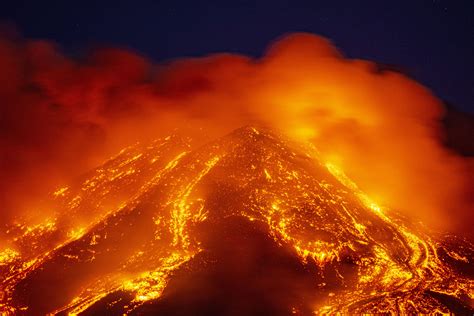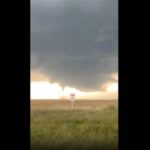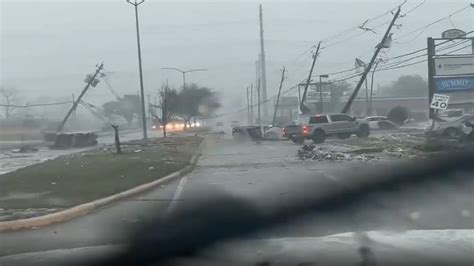
Mount Etna, Europe’s largest and most active volcano, has once again roared to life, spewing ash high into the sky and transforming into a mesmerizing lava fountain, as captured in stunning photographs released this week. The eruption, the latest in a series of recent displays from the Sicilian volcano, has prompted local authorities to monitor the situation closely, though no immediate evacuations have been ordered.
Fiery Spectacle on Mount Etna: Volcanic Activity Intensifies
Italy’s Mount Etna is currently experiencing a renewed phase of volcanic activity, captivating onlookers with dramatic displays of ash plumes and lava flows. The volcano, a prominent landmark in Sicily, has been exhibiting increased activity in recent weeks, culminating in a visually striking eruption that has drawn international attention. According to reports, the eruption sent ash clouds soaring into the atmosphere, while molten lava illuminated the night sky, creating a spectacular, albeit potentially hazardous, scene.
The recent eruption is part of Etna’s ongoing cycle of activity. The volcano is known for its frequent eruptions, which vary in intensity and duration. This latest episode is characterized by Strombolian activity, a type of volcanic eruption that features moderate bursts of gas and lava, resulting in the ejection of incandescent cinder, lapilli, and lava bombs. These eruptions are named after the Stromboli volcano, another Italian volcano known for its persistent activity.
The visual impact of the eruption has been significant. “Stunning photos show the volcano sending ash into the sky and turning into a lava fountain,” as reported by news outlets covering the event. The images and videos circulating online showcase the raw power of nature, with fiery debris showering the slopes of the volcano and ash plumes drifting across the landscape.
Monitoring and Safety Measures
Local authorities and volcanologists are closely monitoring Etna’s activity to assess the potential risks and ensure the safety of nearby communities. The National Institute of Geophysics and Volcanology (INGV) is responsible for monitoring volcanic activity in Italy and provides regular updates on Etna’s status. Their monitoring efforts include seismic monitoring, ground deformation measurements, and gas emission analysis.
While the eruption has not necessitated immediate evacuations, officials are prepared to take action if the situation escalates. Contingency plans are in place to evacuate residents in the event of increased lava flows, ashfall, or other hazardous conditions. The main concerns associated with Etna’s eruptions include:
- Ashfall: Volcanic ash can disrupt air travel, contaminate water supplies, and cause respiratory problems.
- Lava Flows: Lava flows can destroy infrastructure and pose a direct threat to communities in their path.
- Pyroclastic Flows: Pyroclastic flows are fast-moving currents of hot gas and volcanic debris that can be extremely dangerous.
- Lahars: Lahars are mudflows composed of volcanic ash, rock, and water. They can be triggered by heavy rainfall or the melting of snow and ice.
The authorities are advising residents to take precautions to protect themselves from ashfall, such as wearing masks and staying indoors when possible. They are also urging people to avoid areas close to the volcano’s summit and to stay informed about the latest developments.
Etna’s Geological Significance
Mount Etna is not only a visually stunning natural wonder but also a significant geological feature. It is one of the most studied volcanoes in the world, providing valuable insights into volcanic processes and the Earth’s internal dynamics. Etna’s geological history dates back approximately 500,000 years, and its formation is linked to the complex tectonic interactions between the African and Eurasian plates.
The volcano is characterized by a complex structure, comprising multiple vents and craters. Its activity is influenced by a combination of factors, including the composition of the magma, the rate of magma supply, and the structural features of the volcano. Etna’s eruptions are typically effusive, involving the slow outflow of lava, but can also be explosive, producing ash plumes and pyroclastic flows.
Etna’s location in a densely populated region presents both challenges and opportunities. The fertile volcanic soils support agriculture, particularly the cultivation of vineyards and orchards. The volcano also attracts tourists from around the world, contributing to the local economy. However, the potential risks associated with volcanic activity require careful management and preparedness.
Impact on Air Travel
One of the immediate concerns following the eruption is the impact on air travel. Volcanic ash can be extremely hazardous to aircraft, as it can damage engines and reduce visibility. Aviation authorities closely monitor ash plumes from Etna and may impose restrictions on flights in the affected areas. Catania Airport, the main airport serving eastern Sicily, has been temporarily closed or experienced disruptions in the past due to Etna’s eruptions.
The decision to close or restrict air traffic is based on several factors, including the height and density of the ash plume, the wind direction, and the availability of alternative flight routes. Airlines and air traffic control agencies work together to ensure the safety of passengers and crew.
The economic impact of flight disruptions can be significant, affecting tourism, trade, and other sectors. Passengers may experience delays, cancellations, and rerouting, leading to inconvenience and additional expenses. Airlines may incur losses due to reduced capacity and increased operating costs.
Previous Eruptions and Historical Context
Mount Etna has a long history of eruptions, dating back thousands of years. Some of the most significant eruptions in recent history include:
- 1669: This eruption was one of the most destructive in Etna’s history, destroying numerous villages and reaching the city of Catania.
- 1928: This eruption destroyed the town of Mascali, demonstrating the potential for volcanic activity to cause significant damage.
- 1971: This eruption threatened several villages and prompted evacuations.
- 1991-1993: This prolonged eruption produced large lava flows that threatened the town of Zafferana Etnea.
- 2002-2003: This eruption caused significant damage to infrastructure and disrupted tourism.
These past eruptions serve as a reminder of the ongoing threat posed by Mount Etna and the importance of preparedness. They also provide valuable data for volcanologists studying the volcano’s behavior and developing models to predict future eruptions.
The Science Behind Etna’s Activity
Understanding the science behind Etna’s activity is crucial for assessing the risks and developing mitigation strategies. Etna is a stratovolcano, a type of volcano characterized by its conical shape and layered structure. It is formed by the accumulation of lava flows, ash deposits, and other volcanic materials.
The volcano is located in a complex tectonic setting, where the African plate is subducting beneath the Eurasian plate. This process generates magma, which rises to the surface and fuels Etna’s eruptions. The magma composition varies, influencing the style and intensity of the eruptions.
Volcanologists use a variety of techniques to monitor Etna’s activity, including:
- Seismic Monitoring: Seismometers detect earthquakes and tremors associated with magma movement.
- Ground Deformation Measurements: GPS and satellite radar interferometry (InSAR) measure changes in the volcano’s shape, indicating magma accumulation or deflation.
- Gas Emission Analysis: Gas sensors measure the concentrations of gases such as sulfur dioxide and carbon dioxide, providing insights into magma degassing.
- Thermal Monitoring: Thermal cameras detect heat anomalies, indicating areas of active lava flows or hot spots.
By analyzing these data, volcanologists can gain a better understanding of Etna’s internal processes and improve their ability to forecast future eruptions.
Tourism and the Volcano
Despite the risks, Mount Etna is a popular tourist destination, attracting visitors from around the world. The volcano offers a unique opportunity to witness the power and beauty of nature up close. Tourists can hike to the summit craters, explore lava caves, and observe the volcanic landscape.
Guided tours are available, providing visitors with information about the volcano’s history, geology, and ecology. Safety is a top priority, and tour operators take precautions to minimize the risks associated with volcanic activity.
The tourism industry contributes significantly to the local economy, providing jobs and generating revenue for businesses in the surrounding area. However, the industry also faces challenges, such as the need to balance economic development with environmental protection and safety concerns.
Future Outlook
Mount Etna is expected to continue to be active in the future, with ongoing eruptions of varying intensity. Volcanologists will continue to monitor the volcano closely and provide updates on its status. The development of improved monitoring techniques and forecasting models will enhance the ability to predict future eruptions and mitigate the associated risks.
The ongoing research on Mount Etna will also contribute to a better understanding of volcanic processes in general, providing valuable insights for managing volcanic hazards around the world. The lessons learned from Etna can be applied to other volcanoes, helping to protect communities and infrastructure from the impacts of volcanic activity.
The volcano’s dynamic nature serves as a constant reminder of the power of nature and the importance of living in harmony with the environment. Mount Etna will undoubtedly remain a source of fascination and inspiration for generations to come. The current eruption underscores the need for continued vigilance and preparedness in the face of natural hazards. The resilience of the local communities living in the shadow of the volcano is a testament to their ability to adapt to the challenges and opportunities presented by this unique and dynamic landscape.
The recent volcanic activity also highlights the importance of effective communication and collaboration between scientists, authorities, and the public. By sharing information and working together, they can ensure that communities are well-informed and prepared to respond to volcanic hazards. This collaborative approach is essential for minimizing the risks and maximizing the benefits associated with living near an active volcano.
FAQ: Mount Etna Eruption
Q1: Is Mount Etna dangerous?
A1: Yes, Mount Etna is an active volcano and can be dangerous. Its eruptions can produce ashfall, lava flows, pyroclastic flows, and lahars, all of which pose potential risks to nearby communities and air travel. While authorities closely monitor the volcano and have contingency plans in place, residents are advised to stay informed and take necessary precautions. The dangers depend on the intensity and type of eruption, with some being more hazardous than others. The 1669 eruption, for example, was highly destructive, while more recent eruptions have generally been less severe in terms of direct impact on populated areas. The ongoing monitoring efforts and preparedness measures are crucial for mitigating the risks associated with living near an active volcano.
Q2: Has anyone been hurt in the recent eruption?
A2: Based on current reports, there have been no immediate reports of injuries related to the recent eruption. However, it’s crucial to stay updated with the latest information from local authorities and news outlets, as the situation can change rapidly. The primary concerns are typically related to ashfall and potential disruptions to air travel, rather than direct physical harm from lava flows or pyroclastic activity. The absence of reported injuries is likely due to the volcano’s remote location relative to major population centers and the effectiveness of monitoring and warning systems. However, it is essential to remain vigilant and follow any safety advisories issued by authorities.
Q3: How will this eruption affect air travel?
A3: Volcanic ash from Mount Etna’s eruption can significantly disrupt air travel. Ash particles can damage aircraft engines and reduce visibility, posing a serious safety hazard. Aviation authorities closely monitor the ash plume, and flight restrictions or airport closures may be implemented if the ash cloud poses a threat to air routes. Passengers should check with their airlines for the latest flight information and be prepared for potential delays or cancellations. Catania Airport, in particular, has been affected by previous eruptions and may experience disruptions again. The extent of the impact on air travel depends on the size and density of the ash plume, as well as wind patterns and other meteorological factors.
Q4: How close are the nearest towns to the volcano, and are evacuations likely?
A4: Several towns and villages are located near Mount Etna, including Nicolosi, Zafferana Etnea, and Linguaglossa. These communities are situated on the volcano’s slopes and are accustomed to living in its vicinity. As of the latest reports, no immediate evacuations have been ordered. However, local authorities are closely monitoring the situation, and evacuations could be necessary if the eruption intensifies or lava flows pose a direct threat to populated areas. Contingency plans are in place to ensure the safety of residents in the event of an emergency. The decision to evacuate would depend on the specific characteristics of the eruption and the potential risks to nearby communities. The proximity of these towns to the volcano underscores the importance of ongoing monitoring and preparedness.
Q5: How long is the eruption expected to last?
A5: It is difficult to predict precisely how long Mount Etna’s current eruption will last. Volcanic eruptions can be short-lived, lasting only a few hours or days, or they can persist for weeks, months, or even years. The duration of the eruption depends on various factors, including the supply of magma beneath the volcano, the rate of magma ascent, and the characteristics of the volcanic system. Volcanologists are continuously monitoring Etna’s activity to assess its potential duration and intensity. Residents and visitors should stay informed about the latest updates and follow any guidance provided by authorities. Etna’s frequent and unpredictable eruptions make long-term forecasting challenging, but ongoing monitoring efforts provide valuable insights into its behavior.
Detailed Geological Background and Plate Tectonics
To fully grasp the significance of Mount Etna’s activity, it’s crucial to delve into its geological background and the underlying plate tectonics that drive its eruptions. Etna’s formation is intrinsically linked to the complex interactions between the African and Eurasian tectonic plates. Specifically, the African plate is subducting beneath the Eurasian plate in the Ionian Sea, a process that has been ongoing for millions of years.
This subduction is not a smooth, uniform process. The African plate is denser than the Eurasian plate, causing it to sink into the Earth’s mantle. As the African plate descends, it encounters increasing temperatures and pressures, leading to the release of water and other volatile compounds from the subducting crust. These fluids rise into the overlying mantle wedge, lowering its melting point and generating magma.
The magma generated beneath Etna is primarily basaltic in composition, meaning it is relatively rich in iron and magnesium and has a lower viscosity compared to other types of magma. This basaltic magma rises through the Earth’s crust along pathways created by faults and fractures. As the magma ascends, it can interact with the surrounding crustal rocks, altering its composition and properties.
Etna is situated in a region characterized by complex fault systems and volcanic structures. The volcano itself is built upon a foundation of older volcanic rocks and sedimentary deposits. Over time, repeated eruptions have constructed Etna’s characteristic cone-shaped structure, composed of layers of lava flows, ash deposits, and pyroclastic materials.
The volcano’s structure is also influenced by the presence of multiple vents and craters. The summit area of Etna is characterized by several active craters, which are the primary sites of volcanic activity. These craters can change in size and shape over time due to eruptions and collapses.
The ongoing subduction of the African plate beneath the Eurasian plate ensures a continuous supply of magma to Etna’s volcanic system. This explains why Etna is one of the most active volcanoes in the world, with frequent eruptions of varying intensity. The eruptions are often characterized by Strombolian activity, which involves moderate bursts of gas and lava, resulting in the ejection of incandescent cinder, lapilli, and lava bombs. However, Etna can also produce more explosive eruptions, generating ash plumes, pyroclastic flows, and lahars.
Detailed Monitoring Techniques Employed by INGV
The National Institute of Geophysics and Volcanology (INGV) plays a crucial role in monitoring Mount Etna and providing timely warnings of potential volcanic hazards. INGV employs a sophisticated network of instruments and techniques to track the volcano’s activity and assess its behavior.
-
Seismic Monitoring: INGV operates a network of seismometers around Mount Etna to detect earthquakes and tremors associated with magma movement. These seismic signals can provide valuable information about the location, depth, and intensity of magma activity. Changes in seismic activity, such as an increase in the frequency or magnitude of earthquakes, can indicate an impending eruption.
-
Ground Deformation Measurements: INGV uses GPS (Global Positioning System) and satellite radar interferometry (InSAR) to measure changes in the volcano’s shape. These measurements can detect subtle swelling or deflation of the volcano’s surface, which may indicate magma accumulation or withdrawal. GPS stations are strategically located around Etna to track ground movements with high precision. InSAR uses satellite radar images to measure ground deformation over large areas, providing a comprehensive view of the volcano’s behavior.
-
Gas Emission Analysis: INGV monitors the concentrations of volcanic gases emitted from Etna’s vents. The composition and flux of these gases can provide insights into the processes occurring within the volcano’s plumbing system. For example, an increase in the emission of sulfur dioxide (SO2) can indicate that magma is rising towards the surface. INGV uses a variety of instruments to measure gas emissions, including portable gas analyzers and remote sensing techniques.
-
Thermal Monitoring: INGV uses thermal cameras to detect heat anomalies on Etna’s surface. These thermal images can identify areas of active lava flows, hot spots, and fumaroles. Changes in thermal activity can indicate changes in the volcano’s eruptive state. Thermal monitoring is particularly useful for tracking lava flows and assessing their potential impact on nearby communities.
-
Visual Observation: INGV maintains a network of webcams and observation posts around Mount Etna. These visual observations provide real-time information about the volcano’s activity, such as the height and density of ash plumes, the extent of lava flows, and the presence of pyroclastic activity. Visual observations are essential for confirming the data obtained from other monitoring techniques and for providing a comprehensive understanding of Etna’s behavior.
The data collected from these monitoring techniques are integrated and analyzed by INGV scientists to develop a comprehensive picture of Mount Etna’s activity. INGV provides regular updates on Etna’s status to local authorities, the media, and the public. These updates include information about the volcano’s eruptive state, potential hazards, and safety recommendations.
Economic Impact of Eruptions: Tourism and Agriculture
Mount Etna’s eruptions have both positive and negative impacts on the local economy. The volcano’s fertile volcanic soils support agriculture, particularly the cultivation of vineyards and orchards. The volcanic soils are rich in nutrients and minerals, which enhance the growth and quality of crops. Wine production is a significant industry in the Etna region, with vineyards producing high-quality wines that are exported around the world.
However, eruptions can also damage crops and disrupt agricultural activities. Ashfall can cover plants, reducing their ability to photosynthesize and hindering their growth. Lava flows can destroy vineyards and orchards, causing significant economic losses for farmers.
Tourism is another important sector of the Etna region’s economy. Mount Etna attracts tourists from around the world who come to witness the volcano’s power and beauty. Tourists can hike to the summit craters, explore lava caves, and observe the volcanic landscape. Guided tours are available, providing visitors with information about the volcano’s history, geology, and ecology.
Eruptions can have a mixed impact on tourism. On one hand, eruptions can attract more tourists who are interested in witnessing the volcanic activity. On the other hand, eruptions can disrupt tourism activities, leading to cancellations and reduced visitor numbers. Ashfall can make it difficult to hike to the summit craters, and air travel disruptions can prevent tourists from reaching the region.
The overall economic impact of Etna’s eruptions depends on the intensity and duration of the eruptions, as well as the specific sectors of the economy that are affected. Local authorities work to mitigate the negative impacts of eruptions by providing support to farmers and tourism operators and by implementing measures to protect communities and infrastructure.
Detailed Analysis of the Most Significant Historical Eruptions
Mount Etna has a long history of eruptions, dating back thousands of years. Some of the most significant eruptions in recent history include:
-
1669: This eruption was one of the most destructive in Etna’s history. It began in March 1669 and lasted for several months. The eruption produced a large lava flow that destroyed numerous villages and reached the city of Catania. The lava flow diverted the course of the Amenano River and altered the coastline. The eruption caused widespread destruction and loss of life.
-
1928: This eruption destroyed the town of Mascali. The eruption began in November 1928 and lasted for several weeks. A large lava flow completely engulfed the town, leaving only the church standing. The eruption displaced thousands of people and caused significant economic losses.
-
1971: This eruption threatened several villages and prompted evacuations. The eruption began in May 1971 and lasted for several weeks. Lava flows advanced towards the villages of Fornazzo and Milo, forcing residents to evacuate. The eruption also produced ashfall that disrupted air travel.
-
1991-1993: This prolonged eruption produced large lava flows that threatened the town of Zafferana Etnea. The eruption began in December 1991 and lasted for over a year. A large lava flow advanced towards Zafferana Etnea, threatening to engulf the town. Authorities constructed a large earth barrier to divert the lava flow away from the town. The eruption caused significant disruption to daily life and economic activity.
-
2002-2003: This eruption caused significant damage to infrastructure and disrupted tourism. The eruption began in October 2002 and lasted for several months. The eruption produced ashfall that disrupted air travel and damaged buildings. Lava flows destroyed ski lifts and other tourist facilities.
These past eruptions serve as a reminder of the ongoing threat posed by Mount Etna and the importance of preparedness. They also provide valuable data for volcanologists studying the volcano’s behavior and developing models to predict future eruptions. The lessons learned from these eruptions have helped to improve monitoring techniques, emergency response procedures, and community awareness.
The Future of Mount Etna: Predictions and Mitigation Strategies
Mount Etna is expected to continue to be active in the future, with ongoing eruptions of varying intensity. Volcanologists will continue to monitor the volcano closely and provide updates on its status. The development of improved monitoring techniques and forecasting models will enhance the ability to predict future eruptions and mitigate the associated risks.
One of the key challenges in predicting Etna’s future activity is the volcano’s complex and dynamic nature. Etna’s eruptions are influenced by a variety of factors, including the supply of magma beneath the volcano, the rate of magma ascent, and the characteristics of the volcanic system. These factors can change over time, making it difficult to predict the timing and intensity of future eruptions.
Despite these challenges, volcanologists are making progress in developing more accurate forecasting models. These models incorporate data from a variety of monitoring techniques, including seismic monitoring, ground deformation measurements, gas emission analysis, and thermal monitoring. The models are also based on a better understanding of Etna’s geological history and the processes that drive its eruptions.
In addition to improving forecasting capabilities, it is also important to develop effective mitigation strategies to reduce the risks associated with Etna’s eruptions. These strategies include:
- Land-use planning: Restricting development in areas that are at high risk from lava flows, pyroclastic flows, and lahars.
- Infrastructure protection: Constructing barriers to divert lava flows away from populated areas.
- Emergency preparedness: Developing evacuation plans and providing education to communities about volcanic hazards.
- Public awareness: Raising public awareness about the risks associated with living near an active volcano.
By combining improved forecasting capabilities with effective mitigation strategies, it is possible to reduce the risks associated with Mount Etna’s eruptions and protect communities and infrastructure from the impacts of volcanic activity. The ongoing research on Mount Etna will also contribute to a better understanding of volcanic processes in general, providing valuable insights for managing volcanic hazards around the world. The lessons learned from Etna can be applied to other volcanoes, helping to protect communities and infrastructure from the impacts of volcanic activity.









